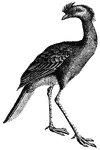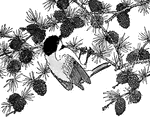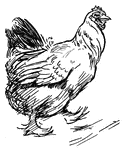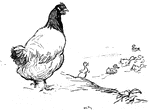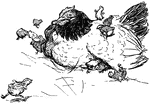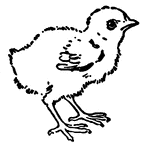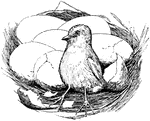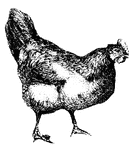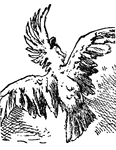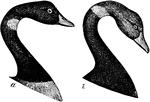
Black Brant Head
"Bernicla nigricans. Black Brant. Bill, feet, and claws black; iris brown. Head and neck all around,…
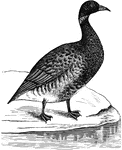
Black Brant
"Bernicla nigricans. Black Brant. Bill, feet, and claws black; iris brown. Head and neck all around,…
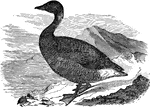
Common Brant
"Bernicla brenta. Brant Goose. Bill, feet, and claws black; iris brown. Head and neck all around, and…

Brazilian Motmot
"The Motmots ... are very wild, and lead an isolated life in the thick forests of South America."

The Foot of a Bridled Foot
"Sterna anaisthetikos. Bridled Tern. The foot of a Bridled Tern; Tarsus .85; middle toe the same, with…
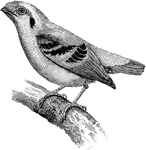
A Broadbill Sitting on a Tree Branch
"The plumage in the Calyptomena viridis of the Indo-Malay countries is bright green, with large black…

Brooch
This brooch is designed in a Renaissance style with a figure in the center and a bird on each side.
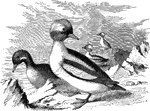
Buffleheads
"Clangula albeola. Buffle-head. Butter-ball. spirit-duck. Dipper. Bill with nostrils rather behind than…
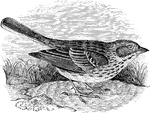
Bay-winged Bunting
"Pooecetes gramineus. Grass Finch. Bay-winged Bunting. Vesper-bird. Above, grayish-brown, closely and…
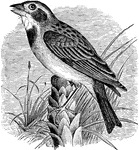
Black-throated Bunting
"Spiza americana. Black Throated Bunting. Above, grayish-brown, the middle of the back streaked with…

Lark Bunting
"Calamospiza bicolor. Lark Bunting. White-winged Blackbird. Black, with A large white patch on the wings;…
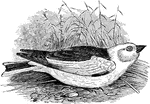
Snow Bunting
"Plectrophanes nivalis. Snow Bunting. Snowflake. Pure white; the bill, feet, middle of back, scapulars,…
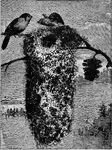
Two Least Bush-Tit Sitting on their Nest
"Dull lead-color, frequently with a brownish or olivaceous shade, the top of the head abruptly darker…
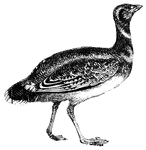
Bustard
Bustards are stocky birds with strong legs. They fly with difficulty, and do not fly unless necessary.
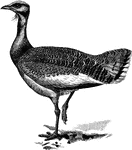
Great Bustard
"The Otis Tarda, the Great Bustard, which, as a native only became extinct in Norfolk about 1838, used…

Butcher-bird
"Lanius borealis. Great Northern Shrike. Butcher-bird. Great Grey Shrike. Above, clear bluish-ash, blanching…

Butcher-bird Head
"Lanius borealis. Great Northern Shrike. Butcher-bird. Great Grey Shrike. Above, clear bluish-ash, blanching…
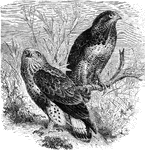
American Rough-legged Buzzard
"Archibuteo lagopus sancti-johannis. American Rough-legged Buzzard. "Black Hawk" Adult: Too variable…

Red-tailed Buzzard
"Buteo borealis. Red-tailed Buzzard. "Hen Hawk". Upper surface of tail rich chestnut, with white tip…
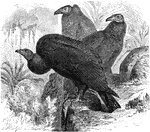
Turkey Buzzard
"Cathartes aura. Turkey Buzzard. Blackih-brown, grayer on the wing-coverts; quills black, ashy-gray…
Canopy
This canopy is made out of carved wood in a design of spikes, leaf scrolls and two birds at the base.…
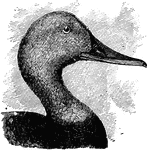
Canvas-back Head
"Fuligula vallisneria. Canvas-back. Adult male: The head close-feathered. Bill high at the base and…
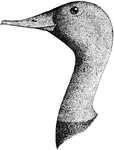
Large Canvas-backs Head
"Fuligula vallisneria. Canvas-back. Adult male: The head close-feathered. Bill high at the base and…
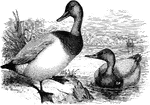
Canvas-backs
"Fuligula vallisneria. Canvas-back. Adult male: The head close-feathered. Bill high at the base and…
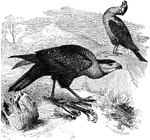
Caracaras
"Polyborus auduboni. Common Caracara. General color blackish, the throat, neck all around, and more…
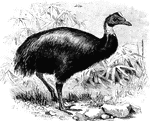
One-wattled Cassowary
One-wattled Cassowary "...Casuarius uniappendiculatus, of Salawatti and the adjoining parts of New Guinea,…

Scutellate Laminiplanter Tarsus of a Cat-bird
"Figure shows Scutellate laminiplanter tarsus of a cat-bird. A tarsus so disposed as to its podotheca…

Catbird
"Cat-Bird. Slate-gray, paler and more grayish-plumbeous below; crown of head, tail, bill, and feet black.…
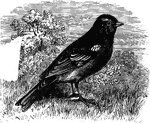
Chaffinch
Fringilla coelebs. Chaffinch. A small finch with edges of the tail being white, white bars on wings,…

Yellow-breasted Chat
"Yellow-breasted Chat or Icteria virens. Bright olive-green, below golden-yellow, belly abruptly white;…
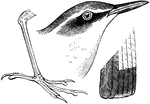
Stone Chats
"Bill shorter than head, slender, straight, depressed at base, compressed at end, notched. Wings long,…
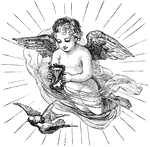
Cherub with Hourglass
A winged child holds an hourglass over a pair of birds. The hourglass usually represents the passing…
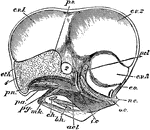
Chick Head
"Fig 66 - Head of a chick, second stage, after five days of incubation, section in profile; x6 diameters.…

The Skull of a Chick Stage Three
"Skull of chick, third stage, viewed from below, x6 & 2/3 diameters. pn, prenasal cartilage, running…

The Skull of a Chick Stage Two
"Skull of chick, second stage, in profile, brain and membranes removed to show cartilaginous formations,…

Ripe Chick's Skull Profile
"Ripe chick's skull, longitudinal section, vied inside, x 3 diameters; after Parker. px, premaxillary;…

Ripe Chick's Skull
"Ripe chick's skull, longitudinal section, vied inside, x 3 diameters; after parker. In the mandible…

Black-capped Chickadee
"Crown and nape, with chin and throat, black, separated by white sides of the head. Upper parts brownish-ash,…

Mountain Chickadee
"Upper part ashy-gray, with scarcely a shade, and only on the rump, under parts similarly grayish-white,…
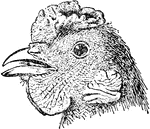
Head of Pea Comb Chicken
An illustration showing the pea comb chicken. The chicken's breed name comes form the comb, or the crest…
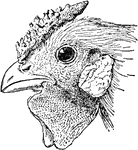
Head of Rose Comb Chicken
A head of the rose comb chicken. The crest on top of the chicken has a distinctive wrinkled feature.

Single Comb Chicken Head
A head of a single comb chicken. The chicken's comb is smooth and standing on the head. The absence…
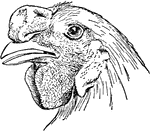
Chicken Head with Walnut Comb
A head of the walnut comb chicken. The breeding of the rose and pea comb chickens results in a walnut…
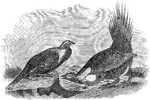
Cock of the plains
An illustration of two cock of the plains also known by its scientific name Centrocercus urophasianus.

Leadbeater's Cockatoo Sitting on a Tree Branch
"Cacatuo leadbeateri, Leadbeater's Cockatoo, has a red crest banded with yellow and tipped with white,…


